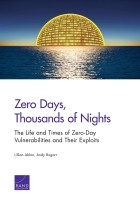| 来源类型 | Research Reports
|
| 规范类型 | 报告
|
| DOI | https://doi.org/10.7249/RR1751
|
| ISBN | 9780833097613
|
| 来源ID | RR-1751-RC
|
| Zero Days, Thousands of Nights: The Life and Times of Zero-Day Vulnerabilities and Their Exploits |
| Lillian Ablon; Andy Bogart
|
| 发表日期 | 2017
|
| 出版年 | 2017
|
| 页码 | 132
|
| 语种 | 英语
|
| 结论 |
"Alive" Versus "Dead" Is Too Simplistic- Vulnerabilities that are alive (publicly unknown) are those that are actively sought out by defenders — called "living" vulnerabilities — or those that will remain in a product in perpetuity because the vendor no longer maintains the code or issues updates — called "immortal" vulnerabilities.
- Among vulnerabilities that are dead (publicly known), many are disclosed with a security advisory or patch, but in other cases developers or vulnerability researchers post online about a vulnerability but no security advisory is issued.
- There are still other vulnerabilities that are quasi-alive ("zombies"), because, due to code revisions, they can be exploited in older versions but not the latest version of a product.
Longevity and Discovery by Others- Zero-day exploits and their underlying vulnerabilities have a rather long average life expectancy (6.9 years). Only 25 percent of vulnerabilities do not survive to 1.51 years, and only 25 percent live more than 9.5 years.
- No vulnerability characteristics indicated a long or short life; however, future analyses may want to examine Linux versus other platform types, the similarity of open and closed source code, and exploit class type.
- For a given stockpile of zero-day vulnerabilities, after a year, approximately 5.7 percent have been publicly discovered and disclosed by another entity.
Time and Costs Involved in Developing Zero-Day Exploits- Once an exploitable vulnerability has been found, time to develop a fully functioning exploit is relatively fast, with a median time of 22 days.
- The cost to develop an exploit can rely on many factors, including the time to find a viable vulnerability, time to develop an exploit, the time and costs involved in testing and analysis, the time to integrate an exploit into other ongoing operations, the salaries of the researchers involved, and the likelihood of having to revisit the exploit and update it in response to code revisions.
|
| 主题 | Computer Viruses
; Cyber and Data Sciences
; Cyber Warfare
; Cybercrime
; Cybersecurity
; The Internet
; Science
; Technology
; and Innovation Policy
|
| URL | https://www.rand.org/pubs/research_reports/RR1751.html
|
| 来源智库 | RAND Corporation (United States)
|
| 引用统计 |
|
| 资源类型 | 智库出版物
|
| 条目标识符 | http://119.78.100.153/handle/2XGU8XDN/108685
|
推荐引用方式
GB/T 7714 |
Lillian Ablon,Andy Bogart. Zero Days, Thousands of Nights: The Life and Times of Zero-Day Vulnerabilities and Their Exploits. 2017.
|
|
文件名:
|
x1543588899137.jpg
|
|
格式:
|
JPEG
|

|
文件名:
|
RAND_RR1751.pdf
|
|
格式:
|
Adobe PDF
|
除非特别说明,本系统中所有内容都受版权保护,并保留所有权利。